Abstract
In countries with high heating demand, waste heat from industrial processes should be carefully utilized in buildings. Finland already has an extensive district heating grid and large amounts of combined heat and power generation. However, despite the average climate, there is little use for excess heat in summer. Waste incineration plants need to be running regardless of weather, so long-term storage of heat requires consideration. However, no seasonal energy storage systems are currently in operation in connection with Finnish waste incineration plants. This study used dynamic energy simulation performed with the TRNSYS 17 software to analyze the case of utilizing excess heat from waste incineration to supplement conventional district heating of a new residential area. Seasonal energy storage was utilized through a borehole thermal energy storage (BTES) system. Parametric runs using 36 different storage configurations were performed to find out the cost and performance range of such plans. Annual energy storage efficiencies from 48% to 69% were obtained for the BTES. Waste heat could generate 37–89% of the annual heat demand. Cost estimations of waste heat storage using BTES are not available in the literature. As an important finding in this study, a levelized cost of heat of 10.5–23.5 €/MWh was obtained for various BTES configurations used for incineration waste heat storage. In the three most effective cases, the stored heat reduced annual CO2 emissions of the residential area by 42%, 64% and 86%. Thus, the solution shows great potential for reducing carbon emissions of district heating in grids connected to waste incineration plants.
1. Introduction
In the heating dominated climate of Nordic countries, heating demand surpasses electricity demand. In Finland, Sweden and Denmark, the combined heating demand is about 400 TWh and is mostly met through district heating [1]. However, district heating is typically produced through combustion of fossil fuels, biomass or solid waste, all of which produce carbon emissions. Thus, there is great potential for reducing carbon emissions in the district heating sector. The reductions could be realized through improved system coupling of waste incineration plants and district heating.
Currently, there are many waste incineration plants in Sweden and Finland, which are used for generating electricity and heat. In Finland, 93% of non-sorted mixed waste is utilized for energy generation [2]. The energy sector in Finland is dominated by co-generation plants. Unfortunately, while solid waste is produced all through the year, the demand for heat falls during summer and part of the heat produced by incineration is wasted. In addition, due to the already high energy conversion of waste, energy generated from waste cannot really be increased. Thus, the available energy should be used more effectively.
One solution is seasonal underground thermal energy storage. This could be done using aquifer thermal energy storage (ATES), where heat is moved between a hot and cold water reservoir. It has been successfully utilized in the Swedish Arlanda airport, where thermal energy storage has been reported to supply 22 GWh/a of cooling and low temperature heat. In a Finnish study, district cooling was generated using heat pumps and waste heat was stored in the hot reservoir of an ATES system. Heat was produced at the cost of 41.5 €/MWh, while the seasonal storage efficiency was 73–83%.
Unfortunately, appropriate aquifers are not available everywhere. Thus, a more general solution could be obtained by using borehole thermal energy storage (BTES) technology. This means storing heat into the ground itself using boreholes fitted with heat transfer pipes. In many studies, the heat to be stored comes from solar energy [3]. Finnish studies on seasonal solar energy storage have shown that it is technically feasible, but economically problematic. The most expensive components of the system are the solar thermal collectors [4] or the solar photovoltaic panels [5], not the actual storage system. Thus, a system with a free source of heat would be a potential breakthrough.
In Emmaboda, Sweden, a high temperature BTES system was built to store waste heat from industrial processes, such as metalworking [6]. The storage volume had a high thermal conductivity of 3.0 W/mK. There were 140 boreholes, each 150 m deep and equipped with a coaxial double tube borehole heat exchanger (BHE). Seasonal storage efficiency of 68% was expected. However, technical problems prevented heat extraction during the initial test period. Heat was first extracted after the fourth year of operation and design performance was expected to be achieved after the fifth year [7]. Further study of the facility revealed that the industrial waste heat was of lower temperature than expected, which reduced the output from the BTES system [8]. Only 19% storage efficiency was achieved. Total construction and consultancy cost of €1.25 M was reported, but not the cost of produced heat. Other examples on storage of industrial waste heat are scarce.
A 50,000 m3 BTES located in China was designed to utilize both industrial waste heat and solar energy [9]. The supply temperature in the system varied according to the specific process that was supplying the heat at any given moment. However, the maximum temperature for the processes varied from 60 °C to 90 °C. The storage volume had a low thermal conductivity of only 1.1 W/mK. The ground in the core of the BTES was heated up to 40 °C, though this was expected to rise with continued operation. This was purely a technical study with no cost information reported.
One experimental BTES system was connected to a combined heat and power plant in the Czech Republic [10]. The core temperature of the facility reached up to 78.5 °C. This temperature was measured in a dedicated monitoring borehole, so as not to be disturbed by operational heat flows. The average measured thermal conductivity in the ground was a moderate 2.2 W/mK. It was estimated that 65% of injected heat could be sustainably extracted. This is promising for systems intending to utilize heat from waste incineration plants. However, no estimation of the cost of heat was presented.
The main goal of the present study was to show the technical and economic feasibility of borehole thermal energy storage as a supplementary heating system in Finnish district heating grids, where large enough waste heat streams are available. The study also aimed to explain why certain solutions are more cost-effective than others, taking into account the cold Finnish climate and the local ground properties. The novelty of the paper was in the integration of a waste heat process into the district heating system through seasonal storage. No such system yet exists in Finland, but due to the widespread use of district heating and waste-to-energy processes, the potential for reducing carbon dioxide (CO2) emissions is great. Previous studies on the topic did not report the cost of heat produced through the seasonal waste heat storage system. In this study, we explicitly report the levelized cost of heat obtained from a BTES system. Both the emission reduction potential and its cost are novel and useful information for Finnish and Nordic district heating operators. Paste experimental studies analyze just a single storage system configuration, which may or may not be optimal. The parametric runs performed in the study show the performance range and tradeoffs available for optimal waste heat storage systems, which was not presented in the previous studies.
2. Materials and Methods
This study on incineration waste heat recovery was performed using dynamic energy simulation. A flowchart of the whole calculation process is presented in Figure 1.
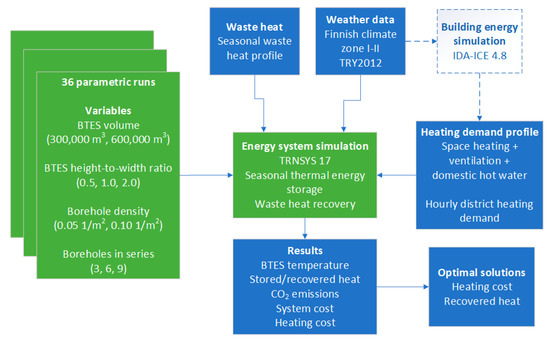
Figure 1.
Flowchart of the calculation process.
Heating demand profiles from a previous simulation study were used as input data for energy storage calculations. Various system configurations were tested and out of all the combinations, a few optimal solutions were chosen based on the cost of heat and the amount of heat recovered from the storage.
2.1. District Information
The goal of the study was to analyze the utilization of waste heat from an incineration plant in a new planned residential district in the Finnish city of Vaasa. Vaasa is located in a subarctic climate of Finnish climate zone II, which is represented by the Finnish Test Reference Year 2012 (TRY2012) weather data of Vantaa [11]. The average ambient air temperature in TRY2012 is 5.6 °C. The heating degree day value (S17) for Vaasa in the reference period (1980–2010) was 4469 Kd. The district comprised apartment buildings built according to energy performance requirements of the 2010 Finnish building code [12], with a specific annual heating demand of 64.5 kWh/m2. With 130,000 m2 of heated floor area, this corresponds to 8.4 GWh total annual heating demand. Space heating, ventilation and domestic hot water (DHW) consumption profiles were obtained from a previous study [13], in which an apartment building was simulated using the IDA-ICE 4.8 simulation tool [14]. The different demands were combined into a single hourly energy demand profile, which was normalized to the building code requirement.
2.2. Energy System
The planned district was supplied with waste incineration heat and conventional district heating (DH). A TRNSYS model was created to simulate the interaction of a seasonal borehole thermal energy storage (BTES) system with the conventional district heating network and the buildings themselves. The BTES system was a field of boreholes drilled into the ground and fitted with U-tube heat transfer pipes. Heat exchangers (HX) between the DH grid and the BTES were ideal (Type 91) with 95% efficiency. The BTES system was modelled in TRNSYS using Type 557a. The heat capacity of the ground was 2240 kJ/m3K with a high heat conductivity of 3.5 W/mK [15]. The top surface of the BTES system was covered by a 10 cm polystyrene (Styrofoam) insulation layer to reduce heat losses. Thermal conductivity of the Styrofoam was 0.03 W/mK [16]. The sides of the BTES system and the boreholes themselves were not insulated. The starting temperature of the ground was 5.6 °C [15]. The borehole width was 15 cm and the inner diameter of the U-tube pipe was 3.2 cm.
The boreholes in the BTES system were distributed uniformly in a cylindrical volume. Some of the boreholes were connected in series, such that the hot water for charging was fed into the center of the storage and taken out at the outside edge, going through several boreholes in the process. During discharging, the flow direction was reversed, such that cold water was supplied from the edges. A higher number of series-connected boreholes increases heat transfer efficiency, while reducing the total flow rate and power. It also creates a larger radial temperature difference in the storage, reducing heat losses. This is visualized in Figure 2, which shows a borehole field and the principle of series connection between boreholes (in charging mode).
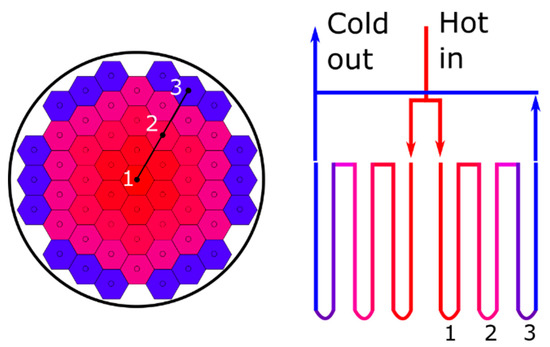
Figure 2.
The operational principle of borehole thermal energy storage (BTES). The horizontal BTES cross-section (left) shows the borehole grid and the radial heat distribution with a hot core and cooler edges. The series connection of boreholes (right) results in a larger temperature change in the heat transfer fluid.
The inlet flow sheds a part of its energy into the central borehole, cooling down in the process. The flow is then redirected to another borehole, cooling down more and finally exiting from the outer borehole at the lowest temperature.
The efficiency of the BTES was defined as, Equation (1):
where Eextracted is the amount of energy taken out of the storage over a year and Echarged is the energy charged into the storage over the same time.
η = Eextracted/Echarged
During the heating season, all of the heat in the waste incineration plant was used elsewhere in the city, but in summer there was excess heat available to be used in the new district. According to the local utility, there was 45 GWh of excess heat available from the incineration plant during summer. This was much more than even the annual heating demand of the new district. Thus, all heating demand during summer was covered by the waste heat and any excess could be charged in the seasonal energy storage system. The monthly heating demands are shown in Figure 3.
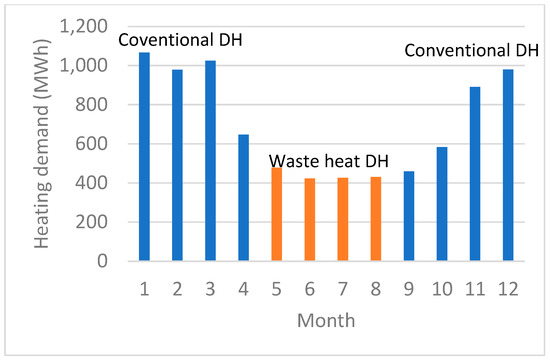
Figure 3.
Monthly heating demand in the residential district without seasonal energy storage. The blue color shows when heating is provided by conventional district heating and the orange shows when waste heat is directly utilized.
During the winter months, the monthly heating demand in the district is about 1000 MWh, while during summer the monthly demand remains below 500 MWh.
Waste heat was available from the start of May to the end of August, which limited the charging time of the BTES to four months. For this reason, the charging flowrate to the BTES was 1600 kg/h per borehole loop, while the discharge flowrate was lower at 1200 kg/h per borehole loop.
The new district utilized a low temperature local heating grid with 70 °C supply temperature and 30 °C return temperature from the buildings. The BTES was connected to the conventional district heating system in series, as shown in Figure 4 and Figure 5.
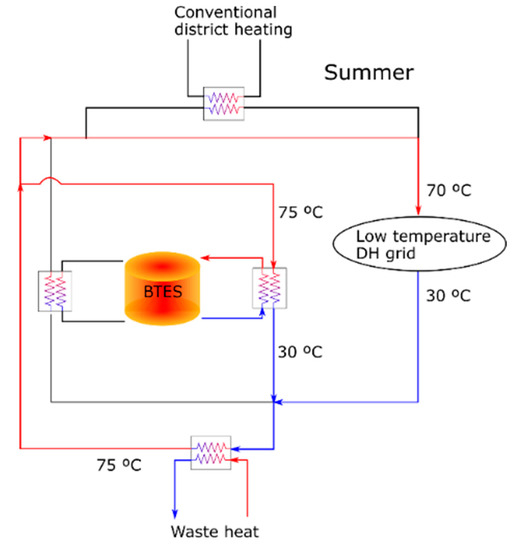
Figure 4.
BTES charging mode (summer).
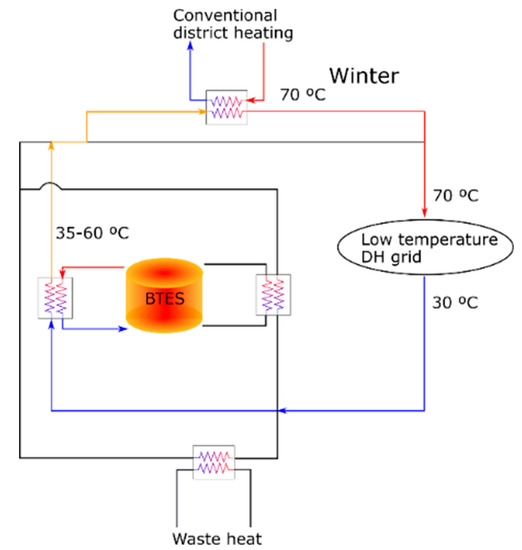
Figure 5.
BTES discharging mode (winter).
In summer (Figure 4), waste heat was supplied directly to the low temperature heating grid and to charge the BTES. In winter (Figure 5), the return flow from the local grid was preheated using the BTES and then heated to the required temperature level (70 °C) with the conventional district heating. Heat transfer and losses in the district heating pipes were not modelled, only the connection between the BTES and other grids was modelled. The carbon dioxide emission factor of the conventional district heating was assumed to match the national average of 194 kg-CO2/MWh [17]. Heat produced by otherwise wasted incineration heat was assumed to have no emissions.
2.3. Cost Calculation
The cost analysis was limited to the direct investment costs of the BTES system, which were the cost of boreholes and piping at 33.5 €/m and the cost of the BTES polystyrene insulation cover at 83.3 €/m3. The cover was 10 cm thick in every scenario. The district heating grid was assumed to be installed regardless of the BTES system and no extra costs were attached to it. The BTES system was assumed to require annual maintenance valued at 0.5% of the investment cost. The levelized cost of heat (LCOH) was calculated over a 25-year period. Discounting was done using a 3% interest rate and 2% energy price escalation [18].
2.4. Parametric Runs
For the new storage-based heating system to be economically feasible, it needs to be competitive with the conventional heat generation system. According to district heating operators, a levelized cost of heat below 20 €/MWh would be preferable for widespread adoption [19]. For comparison, the after-tax consumer price for district heating in Helsinki in 2020 was 35–66 €/MWh [20]. Parametric runs were performed with various BTES configurations, to see how the economics changed. The variables were the volume of the rock used for storage (VBTES, 300,000 and 600,000 m3), the height-to-width ratio of the cylindrical storage (hratio, 0.5, 1.0 and 2.0 m/m), the areal density of boreholes (BH) on the BTES surface, i.e., how many boreholes per area (BH density, 0.05 and 0.10 1/m2) and the number of boreholes connected in series (Nseries, 3, 6, 9). The settings of the parametric runs are displayed in Table 1.

Table 1.
Parameters of the different borehole thermal energy storage (BTES) configurations tested.
The parametric runs included all combinations of the mentioned variables. Under these shapes and sizes, the diameter of the BTES varied between 58 and 115 m, while the depth of the BTES varied between 46 and 145 m. The number of boreholes was between 130 and 656 for the smaller BTES size and between 207 and 1042 for the larger BTES size.
The volume of 300,000 m3 (small) and 600,000 m3 (large) corresponded to heat storage capacities of 3.5 GWh and 7 GWh, respectively. Before accounting for losses, these small and large BTES systems should be able to store enough heat to cover 50% and 100% of the winter heating demand, respectively. The height-to-width ratio has an effect on heat losses through the uninsulated sides and the insulated top, while the BH density affects the heat transfer power. Having more boreholes connected in series increases the potential temperature change achieved by the underground heat collectors, but reduces the total flow and heat transfer power in the system.
3. Results
3.1. All Cases
The results of the parametric run are presented in Table 2, arranged according to levelized cost of heat.

Table 2.
Results of the parametric run arranged by levelized cost of heat (LCOH). Highlighted in bold are three cases determined through the Pareto optimality condition based on maximal heat output and minimal LCOH. See Section 2.4.
The reported results are the heat extracted from the BTES during the fifth year (BTES heat output), the fraction of stored heat that was utilized during the fifth year (BTES efficiency), the fraction of annual heating demand covered by incineration waste heat during the fifth year and the levelized cost of heat over the whole 25-year calculation period (LCOH).
There was a correlation between higher cost and higher heat output from the storage, but there were also exceptions to the rule. The LCOH in the examined cases ranged from 10.5 to 23.5 €/MWh. Compared with the 56 €/MWh district heating price in Vaasa, the cost of heat was low enough to be of economic interest to utilities. The heat output from BTES was 1380–5717 MWh. The direct utilization of waste heat during summer was 1758 MWh, so the BTES increased waste heat use by 78–325%. The annual efficiency of the BTES varied between 48.1% and 69.2% and the total waste heat utilization factor (over the whole year) was 37.4–89.1%. The charging temperature in all cases was 75 °C.
Three solutions (cases 1, 4 and 22) were presented in a bold font to show the most cost-effective cases for different energy output levels. These solutions are also shown in Figure 6, alongside all the other examined cases.
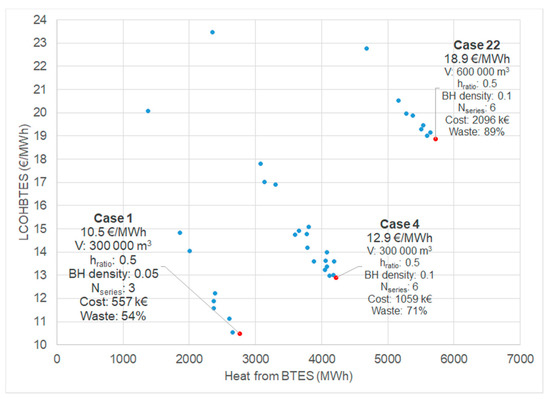
Figure 6.
Three highlighted cases based on Pareto optimal selection from all simulated cases.
The solutions were arranged according to LCOH and BTES heat utilization and the three highlighted solutions were selected based on the Pareto optimality concept. A Pareto optimal solution is one where one property of a solution cannot be improved without making another worse. Thus, three points were chosen by trying to minimize LCOH and maximize BTES heat at the same time. Details of the highlighted solutions are reported in Figure 6.
The figure shows three clusters of solutions, which are analyzed further in the following paragraphs. The levelized cost of heat was determined for all cases. Figure 7 shows the LCOH as a function of heat discharged from the BTES during the fifth year of operation, separated by storage size and borehole density.
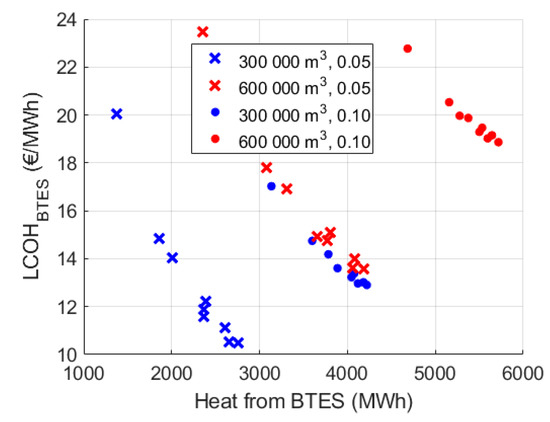
Figure 7.
Levelized cost of heat as a function of the fifth-year heat output from the BTES for all examined scenarios. The results are classified according to BTES volume and borehole density.
Three different clusters could be identified along these criteria. The clusters were separated by BTES volume and borehole density. The middle cluster actually combined two different sets of solutions: (i) those with small volume and high borehole density and (ii) those with large volume and low borehole density. Doubling the volume had a similar effect on cost and heat recovery as doubling the borehole density. Both measures increased the number of boreholes, which increased heat transfer capacity and energy provision, but also raised the cost of heating. Increasing the number of boreholes had the same effect under both BTES sizes. Each cluster had a negative linear correlation between heat cost and energy output. The difference in investment costs within each cluster was minimal, which was why increased energy utilization directly reduced the cost of heating.
The same results are presented in Figure 8, but separated by height-to-width ratio and the number of boreholes in series.
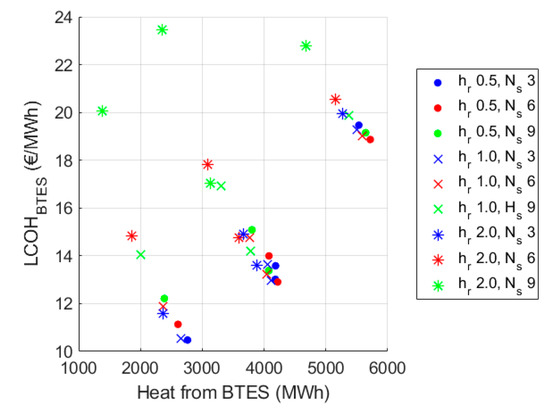
Figure 8.
Levelized cost of heat as a function of the fifth-year heat output from the BTES for all examined scenarios. The results are classified according to BTES height-to-width ratio and the number of boreholes connected in series.
In each line of solutions, the most expensive ones were those with a hratio of 2, meaning BTES systems that were deep and narrow. This could also be seen in Table 2, where the five most expensive solutions had a narrow BTES. If 9 boreholes were connected in series (green), the best shape was a wide one (hratio, 0.5). Conversely, for a narrow BTES (hratio, 2), the most cost-effective method was to connect only 3 boreholes in series. When many boreholes were connected in series, the total heat transfer in and out of the storage went down, because the total flow rate was lowered. This might be compensated by increasing the total number of boreholes, which could be done by reducing the height-to-width ratio or by increasing the borehole density. In each solution cluster, the wide BTES shape was the most cost-effective, but the difference to the even shape (hratio, 1) was not great. There seemed to be a sweet spot of borehole connectivity. Having more boreholes (higher borehole density) favored connecting 6 boreholes in series, instead of 3. More seriality resulted in a higher temperature change of the heat transfer fluid, potentially reducing the need for priming by district heat. However, if the total flow rate, i.e., the number of boreholes was too low, the need for conventional district heating did not change. A balance was required between the output temperature and flow rate on the supply side and power demand and temperature requirement on the demand side. However, the importance of the temperature provided by the BTES would rise if the storage was connected to the DH grid in parallel instead of in series (as in this study).
Figure 9 shows the annual BTES efficiency (fifth year) in all cases as a function of useful heat extraction.
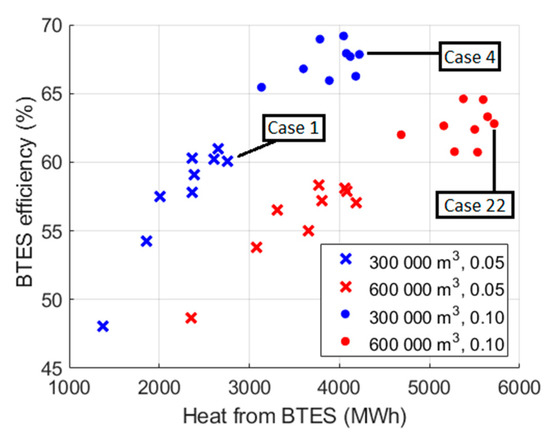
Figure 9.
Seasonal storage efficiency as a function of useful heat output from the BTES.
The attained efficiency range in all configurations was 48–69%, with a median of 61%. The highest efficiency was obtained in the small storage. The storage efficiency was generally greater in the small storage than in the large storage, but with a lower energy output. With all other things being equal, a large storage system should have a higher efficiency because of a more favorable surface area-to-volume ratio. However, this is also influenced by the heating demand. At the end of the heating season, the base temperature level remained higher in the large storage than in the small one. This increased the heat losses in the larger storage system. The small storage system was drained more completely, resulting in increased efficiency. It was more cost-effective to size the storage to cover a smaller part of the heating load. On the other hand, a larger storage was required to cover a larger part of heating demand by waste heat.
The BTES configuration influenced the temperature than can be obtained in the storage. Figure 10 shows the storage efficiency vs. the annual maximum temperature of the BTES.
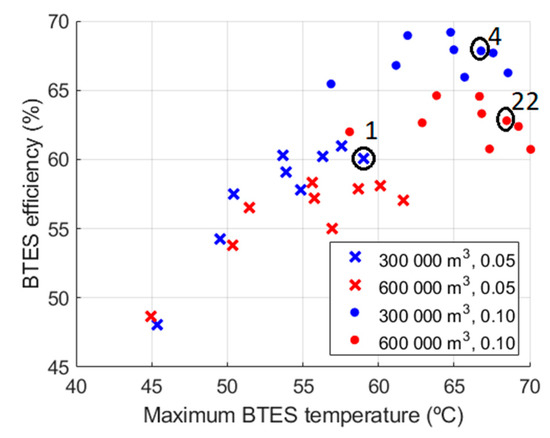
Figure 10.
BTES efficiency as a function of maximum storage temperature. The three best cases are highlighted by circles and case numbers.
The results showed a clear correlation between improved efficiency and rising temperature. One could expect the opposite results, where a high temperature increases heat losses and lowers efficiency. However, the temperature of the storage set a maximum limit on the extraction efficiency. Once the demand-side flow was heated up to the BTES temperature, increasing the flow rate on the storage side did not increase heat extraction. This was demonstrated in Figure 10, where the lowest temperature resulted in the lowest efficiency. In all the cases, the size of the seasonal energy storage was so large that the conductive heat losses caused by high temperatures were dominated by the increased ability to meet the heating demands.
3.2. Development of BTES State
Figure 11 shows how the heat storage efficiency of the BTES system developed during the first five years of simulated operation.

Figure 11.
Development of BTES storage efficiency in all the scenarios during the first five years of operation.
During the first year, most of the excess energy went to raising the BTES temperature from the ambient 5.6 °C to the minimum useful temperature of 30 °C, since no heat pumps were included in the system. This resulted in a storage efficiency of less than 20% in every case. The largest rise in efficiency was observed between the first two years, because it was already possible to use the stored heat during the second year. The improvement was smaller every consecutive year as the system started to reach equilibrium. In some cases, the steady-state condition was reached faster than in others. For example, in the highest efficiency case (case 10), the efficiency improved from 63% to 69% between the third and fifth year. In the lowest efficiency case (case 35), the improvement was from 31% to 49%. The latter case involved a large storage system with low borehole density and maximal seriality, which reduced the charging power. With a proper design, i.e., a high enough heat transfer power relative to the storage volume, the BTES system in the highly conductive rocky Finnish ground could be running close to the full efficiency after three years of operation.
Figure 12 shows the development of the waste heat utilization factor over years of operation.
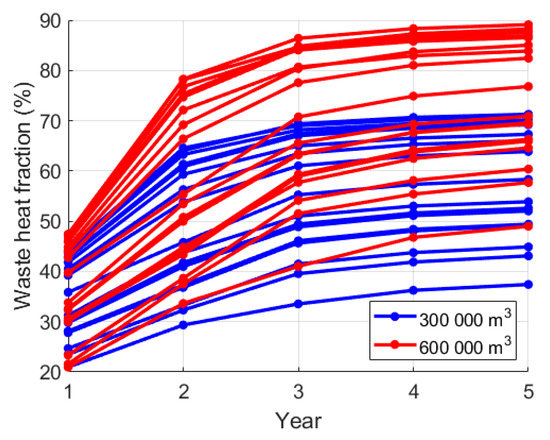
Figure 12.
Development of the amount of heat demand covered by waste heat during the first five years of operation.
The cases with a larger storage system tended to have a higher waste heat utilization than those with a smaller storage system. This was opposite to the BTES efficiency, which was increased for smaller storages. In other words, a small storage system allowed a more effective use of the stored waste heat, but reduced the potential to replace conventional district heating. Conversely, in a large BTES, the high temperature levels could be retained for longer, increasing the demand met by waste heat. The minimum first year levels indicated that without seasonal thermal energy storage, less than 20% of the annual heating demand could be met by waste heat.
Figure 13 shows the operational temperature range in the BTES during the last year for all cases.
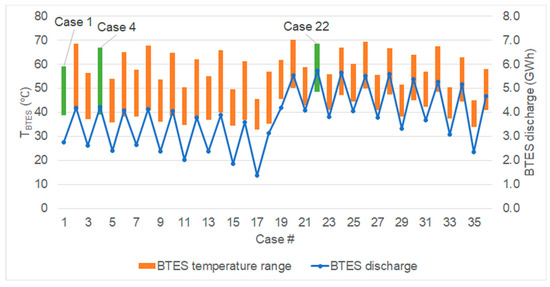
Figure 13.
The operational temperature range of the BTES in each studied case during the fifth year. The best cases are identified by green color.
It also showed how much energy was discharged from the storage over the year. Both the maximum temperature and the discharged heat fluctuated up and down systematically. This was caused by the number of boreholes, which is related to the heat transfer capacity of the BTES system. In odd-numbered cases, the borehole density was 0.05 1/m2, while in even-numbered cases it was 0.1 1/m2. As it could be assumed, with more boreholes, more energy was charged into the ground and the temperature levels were higher. The annual temperature change in the BTES was also directly related to the number of boreholes, since more boreholes resulted in more heating power. This allowed charging the BTES to higher temperature levels, while also increasing the discharging rate and thus lowering the temperature at the end of the heating season. Cases 31, 33 and 35 demonstrated how increasing borehole seriality from 3 to 6 to 9 in a narrow BTES reduced both the temperature levels and recovered energy. Cases 32, 34 and 36 displayed the same trend, but with a higher number of boreholes. This happened with smaller BTES sizes as well, in cases 13 to 18.
3.3. Performance of the Best Cases
Figure 14 shows the monthly energy flows and the monthly average BTES temperature for the three Pareto optimal system configurations (cases 1, 4 and 22).
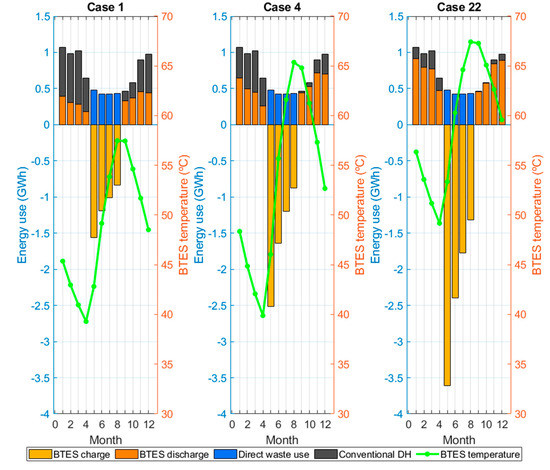
Figure 14.
Monthly energy flows and average BTES temperature in the best cases.
It showed how the utilization of stored waste heat increases changed from case 1 to 4 to 22 (waste heat utilization fractions 54%, 71% and 89%, respectively). This was related to the temperature of the BTES. In case 1, the BTES temperature remained below 58 °C and cooled down to 39 °C at the end of the heating season (in April). In case 4, more heat was charged to the ground, raising the peak temperature to 65 °C, while the minimum temperature remained at 40 °C. The increased charging and discharging potentials were caused by the doubling of the number of boreholes, which directly relates to heat transfer power. In case 22, the size of the BTES was doubled compared with the other two cases. Thus, more heat could be charged into the ground. In this case, the peak temperature rose still higher to 67 °C, while the minimum temperature also went up to 49 °C. A larger share of district heating could be displaced because the BTES remained at higher temperatures. In case 22, the energy injected during the first month of charging was more than three times the peak monthly demand in winter. This could be interpreted as there being significant overcapacity in the BTES, but it was mainly because the system was running constantly on full power during the charging period.
In all cases, the charging of the BTES slowed down as summer progressed, because the rising temperature of the BTES reduced the useful fraction of waste heat that could be stored. Injecting more thermal energy to the BTES got harder as the temperature difference between the storage and heat source diminished. The monthly discharge levels showed how the BTES was drained of energy. The stored energy levels at the start of the year were a result of the charging done during the previous year. In each case, the heat discharged from the BTES got lower each month going from December to April. This was because of the lower temperature level in the BTES, which limited the amount of useful heat available. However, at the end of the year (September–December), the discharged energy rose, even though BTES temperature levels were going down. This was due to the increasing heating demand. Higher demand resulted in higher discharge of energy. However, even in the early discharging period, the relative discharge rate, with respect to the demand, was going down.
The heat provided from the storage replaced 2760, 4220 and 5720 MWh of conventional district heating in cases 1, 4 and 22, respectively. This was on top of the energy provided directly by waste heat in the summer. Assuming the Finnish national average for district heating emissions and that heat recovered from waste incineration was emission-free, the BTES system reduced annual CO2 emissions by 536, 819 and 1109 t-CO2 in cases 1, 4 and 22, respectively. This corresponded to 42%, 64% and 86% reduction in emissions in cases 1, 4 and 22, respectively, compared with the case using waste incineration heat only in the summer months.
Figure 15 displays the hourly temperature development in the BTES for case 4.
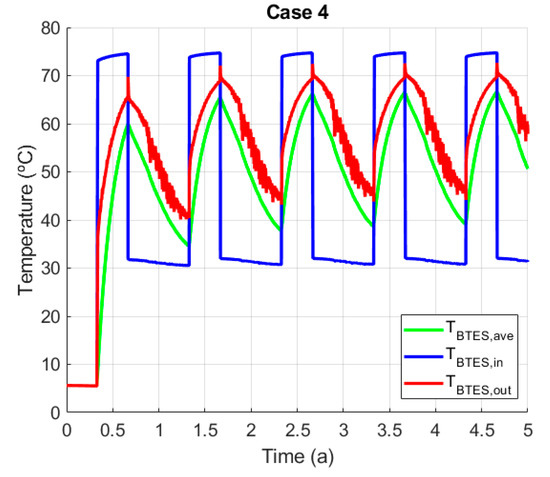
Figure 15.
Hourly temperatures in the storage and district heating (DH) system during five years of operation in case 4. The figure shows the average temperature in the storage volume as well as the inlet and outlet temperatures.
It shows the average temperature of the whole storage volume as well as the inlet and outlet temperatures of the charging/discharging flow. The increase in temperature during the first charging period was large and the BTES almost reached the equilibrium temperatures during the second year. At the start of each charging period (excluding the first one), the temperature difference between inlet and outlet was close to 20 °C, but as the BTES heated up, the temperature difference lowered to 6 °C. Similarly, at the start of the discharging period, the BTES was at maximal temperature and the inlet/outlet difference was about 35 °C, but this was lowered to 15 °C by the end of the heating season.
During the later years of operation, the return temperature from the BTES during charging was 55–70 °C. This was still a useful temperature level, which meant that the output from one seasonal energy storage system could be fed to another one. At first, the temperature change of the charging fluid was close to 20 °C, but it was gradually reduced to 6 °C. This revealed an inefficiency in the system, since less and less of the available energy could be utilized. From a global optimization point of view, it would be more useful to heat several BTES systems to lower temperature levels instead of maximizing the utility of a single system. The result might be reduced waste heat utilization in individual communities, but a rise in total efficiency on the city level.
4. Discussion
4.1. Toward a Net-Zero Energy District
The examined district was designed to be powered by external district heating. However, the waste heat provided by the incinerator plant was stored in a local storage system, reducing reliance on the grid during heating season. Strictly speaking, the district is not generating its own energy, but if the concept of net-zero energy district is expanded to cover the whole city, the community as a whole is moved toward net-zero energy when previously wasted heat is utilized. Looking only at the individual district likely results in suboptimal system performance because of the high return temperatures. To properly use the available incineration heat, the return flow from one BTES system should be redirected to another, to create a city-wide charging loop. The optimal temperature levels in such an interconnected system would be worth further study.
As shown in Figure 15, the temperature of the BTES remained above 40 °C at the end of the discharging period, meaning that there was still a lot of energy stored in the ground. With heat pumps, the total energy extraction could be doubled to bring the district close to zero carbon heating (depending on the type of electricity used). Such a district could completely stop utilizing conventional district heating, but to access the waste heat, a DH connection must be maintained regardless. Thus, it may be sensible to use the connection instead of investing in an overlapping heat pump system.
4.2. Implications and Potential
In Finland, only 2.5% of municipal waste goes to landfills [21]. Most of the municipal waste is incinerated for energy. This means that adding to the total waste heat generation is not feasible. Thus, any increased energy use of waste should result from improved utilization rate of the energy generated during low demand. Here, the BTES system shows its importance. District heating in Finland is produced mainly by coal, peat and wood burning, so any shifting of excess waste heat to the heating period has a great potential for emission reduction.
In the European Union (EU-27), 52 Mt of municipal waste is landfilled and 58 Mt is incinerated [22]. The final space heating demand in Europe is estimated to be over 300 TWh, of which the vast majority is produced by natural gas [23]. The share of district heating could be increased significantly, which leaves room for increased use of incineration heat. Most of Europe has increased heating demand in winter, which opens up the potential for storing the summertime excess heat using borehole thermal energy storage.
If the heat storage concept were to be utilized to the maximum potential in as many communities as possible, any individual community could only utilize a fraction of the available excess heat. This would reduce the maximum temperatures possible to reach in the storage systems and create the need for heat pumps to provide more heat. However, the temperature of the ground would still be significantly elevated compared to the natural state, which would improve the coefficient of performance (COP) of the heat pumps. The waste heat could also be used to regenerate the ground to prevent extensive cooling in a scenario with high penetration of ground heat utilization. In such a regenerating role, the waste heat could be distributed widely with little consideration of the temperature.
In a modern floor heating system, the heat distribution temperature is below 40 °C, while the DHW temperature requirement remains at 55 °C, to avoid Legionella. If DHW demands were met by building-side heat pumps, the district heating temperature could be lowered. This would reduce losses both in the DH distribution and the seasonal storage. Storage size might also be reduced by draining the stored heat more completely using heat pumps. Of course, the addition of heat pumps would entail costs that would need to be balanced with the obtained benefits. The LCOH of heat generated by the BTES was 10–23 €/MWh, which can be compared to the pre-tax average price of district heating in Finland, 66.5 €/MWh [24]. This leaves plenty of room for profits and payments to the waste heat generator.
4.3. Weaknesses and Reliability
The series connection between the BTES and DH resulted in a high return temperature for the DH flow. This may be a problem for the utility that provides district heating. Another study could present an alternative system, which utilizes a parallel connection, maximizing the cooling in the DH flow.
No actual heating grid was modelled, just the boundary of the residential zone. In practice, there would be some heat losses in the local district heating grid. Heat losses in district heating grids have been estimated to be 8–10% [25], but in a low temperature grid in a cold climate they could be around 5% [26]. Electricity consumption of water pumping was also disregarded. Measurements from a real BTES facility revealed that the electricity consumption of pumping was less than 0.4% of the heat injected into the storage [8]. Thus, the lack of pumping energy should not have a significant influence on the operational cost benefits.
A parametric run does not provide optimal results because many potential system configurations are not tested. Another study could use multi-objective optimization, such as with a genetic algorithm, to further improve the cost-effectiveness of the incineration waste heat storage systems.
5. Conclusions
This study analyzed the potential of a seasonal borehole thermal energy storage system for increasing the utilization of waste heat in a residential community. Heat generated by waste incineration in summer was stored in the ground to preheat district heating flows during the heating season. The main finding was that the storage of waste heat turned out to be a promising low-cost measure to reduce district heating consumption and emissions of heating. The median storage efficiency was 61% in the 36 examined cases, even while the temperature of the storage volume exceeded 60 °C in many cases. This showed that relatively high temperature heat can be stored for long periods of time using large enough storage volumes. The many different simulated storage configurations revealed some guidelines for BTES design.
Compared with only using waste heat from incineration in summer, the use of the BTES increased waste heat use by 78–325% in the 36 examined cases. In the three most cost-effective cases, the levelized cost of heat was 10.5, 12.9 and 18.9 €/MWh for waste heat utilization factors of 54%, 71% and 89%, respectively. Most of the heat required by the community could be provided by the incineration plant. The cost of heat compared to average district heating prices was low enough to be of interest to utilities. A more detailed study considering all the integration costs should be performed.
A BTES system in Finland could be heated up to nearly the final operational temperature level in three years. The density of boreholes in the BTES was essential in determining the energy provided by the storage system. More boreholes meant more heating power and higher temperatures, which directly influenced how much useful heat could be recovered during the heating season. All the best BTES configurations utilized a wide and shallow storage system, which creates a stronger radial temperature gradient and reduces heat losses. When the number of boreholes was increased, it became useful to connect more boreholes in series, to increase the output temperature of the BTES at the cost of a lower flow rate.
In many cases, the return temperature from the storage was high, which reveals a potential for further utilization of the same waste heat stream in other districts. The optimization of a network of storage systems to best utilize a singular waste heat source on the city level would be a good avenue for further study.
In the best three cases, the emissions of district heating in the community could be reduced by 536, 819 and 1109 t-CO2/a through the use of the BTES, in addition to the direct use of the waste heat in summer. Operators of waste incineration plants should consider building seasonal thermal energy storage systems to communities within reach of heat-generating incineration plants.
Author Contributions
Conceptualization, J.H.; methodology, J.H.; software, J.H.; validation, J.H.; formal analysis, J.H.; investigation, J.H.; resources, J.H. and R.K.; data curation, J.H.; writing—original draft preparation, J.H.; writing—review and editing, J.H. and R.K.; visualization, J.H.; supervision, R.K.; project administration, R.K.; funding acquisition, R.K. All authors have read and agreed to the published version of the manuscript.
Funding
This research was funded by the Academy of Finland under the “Optimal transformation pathway towards the 2050 low carbon target: integrated building, grids and national energy system for the case of Finland”, grant number 309064.
Acknowledgments
The authors thank Vaasan Sähkö for providing the idea and basic data for the study.
Conflicts of Interest
The authors declare no conflict of interest. The funders had no role in the design of the study; in the collection, analyses, or interpretation of data; in the writing of the manuscript, or in the decision to publish the results.
References
- Patronen, J.; Kaura, E.; Torvestad, C. Nordic Heating and Cooling-Nordic Approach to EU’s Heating and Cooling Strategy-Nordic Council of Ministers; TemaNord: Copenhagen, Denmark, 2017. [Google Scholar]
- Vertanen, V. Municipal Waste Treatment in Finland. Available online: http://www.stat.fi/til/jate/2016/13/jate_2016_13_2018-01-15_tau_001_en.html (accessed on 2 May 2019).
- Gao, L.; Zhao, J.; Tang, Z. A Review on Borehole Seasonal Solar Thermal Energy Storage. Energy Procedia 2015, 70, 209–218. [Google Scholar] [CrossRef]
- Hirvonen, J.; Rehman, H.; Sirén, K. Techno-economic optimization and analysis of a high latitude solar district heating system with seasonal storage, considering different community sizes. Sol. Energy 2018, 162, 472–488. [Google Scholar] [CrossRef]
- Hirvonen, J.; Sirén, K. A novel fully electrified solar heating system with a high renewable fraction-Optimal designs for a high latitude community. Renew. Energy 2018, 127, 298–309. [Google Scholar] [CrossRef]
- Nordell, B.; Andersson, O.; Scorp, A.L. The High Temperature Borehole Thermal Energy Storage Plant in Emmaboda-Report from the First Three Years of Operation 2010–2013, Half-Time Report Luleå University of Technology. Available online: https://www.researchgate.net/publication/273899339_The_high_temperature_Borehole_Thermal_Energy_Storage_plant_in_Emmaboda_-_Report_from_the_first_three_years_of_operation_2010-2013_half-time_report (accessed on 2 April 2019).
- Nordell, B.; Andersson, O.; Rydell, L.; Scorpo, A.L. Long-term performance of the HT-BTES in Emmaboda, Sweden. Presented at Greenstock 2015. In Proceedings of the International Conference on Underground Thermal Energy Storage, Beijing, China, 19 May 2015. [Google Scholar]
- Nilsson, E.; Rohdin, P. Performance evaluation of an industrial borehole thermal energy storage (BTES) project—Experiences from the first seven years of operation. Renew. Energy 2019, 143, 1022–1034. [Google Scholar] [CrossRef]
- Guo, F.; Zhu, X.; Zhang, J.; Yang, X. Large-scale living laboratory of seasonal borehole thermal energy storage system for urban district heating. Appl. Energy 2020, 264, 114763. [Google Scholar] [CrossRef]
- Rapantova, N.; Pospisil, P.; Koziorek, J.; Vojcinak, P.; Grycz, D.; Rozehnal, Z. Optimisation of experimental operation of borehole thermal energy storage. Appl. Energy 2016, 181, 464–476. [Google Scholar] [CrossRef]
- Finnish Meteorological Institute. Test Reference Years for Energy Calculations [In Finnish]. Available online: https://ilmatieteenlaitos.fi/energialaskennan-testivuodet-nyky (accessed on 16 November 2020).
- Ministry of the Environment. Ympäristöministeriön asetus uuden rakennuksen energiatehokkuudesta (1010/2017) (Decree of the Ministry of the Environment on the energy performance of the new building (1010/2017) [In Finnish]. Available online: https://www.finlex.fi/fi/laki/alkup/2017/20171010 (accessed on 16 November 2020).
- Hirvonen, J.; Jokisalo, J.; Heljo, J.; Kosonen, R. Towards the EU emissions targets of 2050: Optimal energy renovation measures of Finnish apartment buildings. Int. J. Sustain. Energy 2018. [Google Scholar] [CrossRef]
- EQUA Simulation AB, Solna, Sweden. IDA ICE—Simulation Software. Available online: https://www.equa.se/en/ida-ice (accessed on 16 November 2020).
- Flynn, C.; Sirén, K. Influence of location and design on the performance of a solar district heating system equipped with borehole seasonal storage. Renew. Energy 2015, 81, 377–388. [Google Scholar] [CrossRef]
- Engineering Toolbox. Thermal Conductivity of Selected Materials and Gases. Available online: https://www.engineeringtoolbox.com/thermal-conductivity-d_429.html (accessed on 23 September 2020).
- Statistics Finland. Tilastokeskus-Energia ja päästöt. Available online: https://pxhopea2.stat.fi/sahkoiset_julkaisut/energia2019/html/suom0011.htm (accessed on 25 September 2020).
- European Commission. Commission Delegated Regulation Supplementing Directive 2010/31/EU of the European Parliament and of the Council on the Energy Performance of Buildings (Recast) by Establishing Energy Performance Requirements for Buildings and Building Elements. Available online: https://ec.europa.eu/transparency/regdoc/rep/3/2011/EN/3-2011-10050-EN-F1-1.Pdf (accessed on 10 September 2020).
- Pieskä, M. Discussion about Waste Heat Storage Potential by a Vaasan Sähkö Oy Representative; Westenergy Oy Ab: Kvevlax, Finland, 2018. [Google Scholar]
- Oy, Helen. Kaukolämmön energia- ja vesivirtamaksut 1.10.2020 alkaen [District Heating Energy and Capacity Costs]. Available online: https://www.helen.fi/globalassets/hinnastot-ja-sopimusehdot/lampo-ja-jaahdytys/kotitaloudet/kaukolammon-energia-ja-vesivirtamaksut-01102020.pdf (accessed on 10 September 2020).
- Statistics Finland. Waste Treatment in 2018. Available online: https://www.stat.fi/til/jate/2018/jate_2018_2020-06-17_tau_002_en.html (accessed on 28 September 2020).
- Eurostat. Municipal Waste Statistics-Statistics Explained. Available online: https://ec.europa.eu/eurostat/statistics-explained/index.php/Municipal_waste_statistics (accessed on 28 September 2020).
- Heat Roadmap Europe. Heating and Cooling Energy Demands. Available online: https://heatroadmap.eu/heating-and-cooling-energy-demand-profiles/ (accessed on 28 September 2020).
- Statistics Finland. Consumer Prices of Heating Energy in March 2020. Available online: https://www.stat.fi/til/ehi/2020/01/ehi_2020_01_2020-06-11_tau_003_en.html (accessed on 25 September 2020).
- Poredos, A.; Kitanovski, A. Exergy loss as a basis for the price of thermal energy. Energy Convers. Manag. 2001, 43, 2163–2173. [Google Scholar] [CrossRef]
- Arabkoohsar, A.; Alsagri, A.S. Thermodynamic analysis of ultralow-temperature district heating system with shared power heat pumps and triple-pipes. Energy 2020, 194, 116918. [Google Scholar] [CrossRef]
Publisher’s Note: MDPI stays neutral with regard to jurisdictional claims in published maps and institutional affiliations. |
© 2020 by the authors. Licensee MDPI, Basel, Switzerland. This article is an open access article distributed under the terms and conditions of the Creative Commons Attribution (CC BY) license (http://creativecommons.org/licenses/by/4.0/).